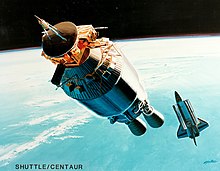 Illustration of Shuttle-Centaur G-Prime with Ulysses | |
| Manufacturer | General Dynamics |
|---|---|
| Country of origin | United States |
| Centaur G-Prime | |
| Height | 9.3 m (31 ft) |
| Diameter | 4.6 m (15 ft) |
| Empty mass | 2,761 kg (6,088 lb) |
| Gross mass | 22,800 kg (50,270 lb) |
| Powered by | 2 x RL10-3-3A |
| Maximum thrust | 73.40 kN (16,500 lbf) (per engine) |
| Specific impulse | 446.4 s |
| Propellant | Liquid hydrogen / LOX |
| Centaur G | |
| Height | 6.1 m (20 ft) |
| Diameter | 4.6 m (15 ft) |
| Empty mass | 3,060 kg (6,750 lb) |
| Gross mass | 16,928 kg (37,319 lb) |
| Powered by | 2 x RL10-3-3B |
| Maximum thrust | 66.70 kN (14,990 lbf) (per engine) |
| Specific impulse | 440.4 s |
| Propellant | Liquid hydrogen / LOX |
Shuttle-Centaur was a version of the Centaur upper stage rocket designed to be carried aloft inside the Space Shuttle and used to launch satellites into high Earth orbits or probes into deep space. Two variants were developed: Centaur G-Prime, which was planned to launch the Galileo and Ulysses robotic probes to Jupiter, and Centaur G, a shortened version planned for use with United States Department of Defense Milstar satellites and the Magellan Venus probe. The powerful Centaur upper stage allowed for heavier deep space probes, and for them to reach Jupiter sooner, prolonging the operational life of the spacecraft. However, neither variant ever flew on a Shuttle. Support for the project came from the United States Air Force (USAF) and the National Reconnaissance Office, which asserted that its classified satellites required the power of Centaur. The USAF agreed to pay half the design and development costs of Centaur G, and the National Aeronautics and Space Administration (NASA) paid the other half.
Both versions were cradled in the reusable Centaur integrated support system (CISS), an aluminum structure that handled communications between the Space Shuttle and the Centaur. All Centaur rockets periodically vented hydrogen, which needs to be stored below −253 °C (−423 °F) to keep it from boiling. Two Shuttle-Centaur missions were scheduled, with one-hour launch windows six days apart, so two separate spacecraft and launch pads were required. The Space Shuttles Challenger and Atlantis were modified to carry the CISS. The Space Shuttle main engines would have been run at 109 percent of the rated power level. The payloads needed to be deployed on the first day in orbit, so the missions would be flown by four-person crews composed of astronauts who had already flown in space and were known to not suffer from space adaptation syndrome. The first Centaur G-Prime was rolled out from the General Dynamics factory in Kearny Mesa, San Diego, on 13 August 1985.
Just months before the Shuttle-Centaur was scheduled to fly, the Challenger disaster occurred, and the project was canceled. The Galileo and Ulysses probes were ultimately launched using the much less powerful solid-fueled Inertial Upper Stage (IUS), Galileo needing multiple gravitational assists from Venus and Earth to reach Jupiter. The USAF mated a variant of the Centaur G-Prime upper stage with its Titan rocket to produce the Titan IV, which made its first flight in 1994. Over the next 18 years, Titan IV and Centaur G-Prime placed eighteen military satellites in orbit.
